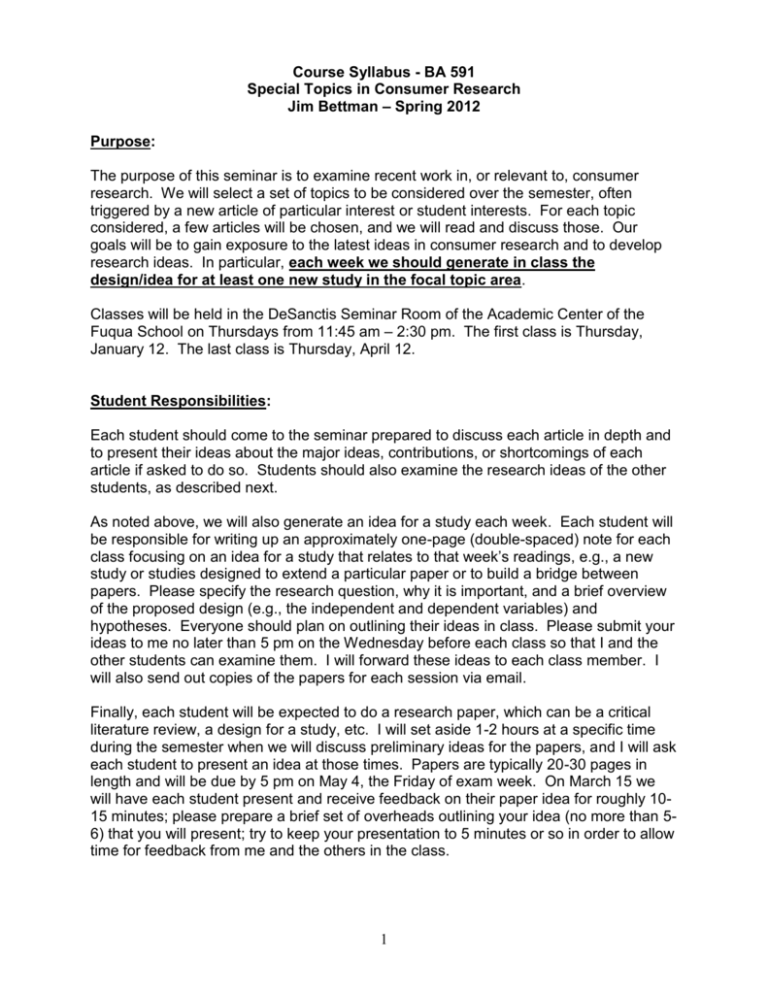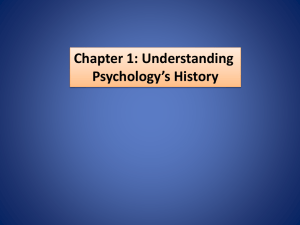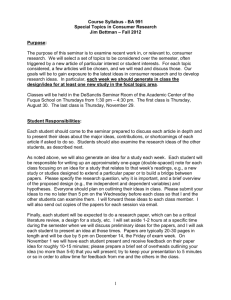BA591 Course Syllabus, Spring 2012
advertisement

Course Syllabus - BA 591 Special Topics in Consumer Research Jim Bettman – Spring 2012 Purpose: The purpose of this seminar is to examine recent work in, or relevant to, consumer research. We will select a set of topics to be considered over the semester, often triggered by a new article of particular interest or student interests. For each topic considered, a few articles will be chosen, and we will read and discuss those. Our goals will be to gain exposure to the latest ideas in consumer research and to develop research ideas. In particular, each week we should generate in class the design/idea for at least one new study in the focal topic area. Classes will be held in the DeSanctis Seminar Room of the Academic Center of the Fuqua School on Thursdays from 11:45 am – 2:30 pm. The first class is Thursday, January 12. The last class is Thursday, April 12. Student Responsibilities: Each student should come to the seminar prepared to discuss each article in depth and to present their ideas about the major ideas, contributions, or shortcomings of each article if asked to do so. Students should also examine the research ideas of the other students, as described next. As noted above, we will also generate an idea for a study each week. Each student will be responsible for writing up an approximately one-page (double-spaced) note for each class focusing on an idea for a study that relates to that week’s readings, e.g., a new study or studies designed to extend a particular paper or to build a bridge between papers. Please specify the research question, why it is important, and a brief overview of the proposed design (e.g., the independent and dependent variables) and hypotheses. Everyone should plan on outlining their ideas in class. Please submit your ideas to me no later than 5 pm on the Wednesday before each class so that I and the other students can examine them. I will forward these ideas to each class member. I will also send out copies of the papers for each session via email. Finally, each student will be expected to do a research paper, which can be a critical literature review, a design for a study, etc. I will set aside 1-2 hours at a specific time during the semester when we will discuss preliminary ideas for the papers, and I will ask each student to present an idea at those times. Papers are typically 20-30 pages in length and will be due by 5 pm on May 4, the Friday of exam week. On March 15 we will have each student present and receive feedback on their paper idea for roughly 1015 minutes; please prepare a brief set of overheads outlining your idea (no more than 56) that you will present; try to keep your presentation to 5 minutes or so in order to allow time for feedback from me and the others in the class. 1 Papers for BA591, Sprint 2012 Session 1 – Negatives of Mimicry – January 12, 2012 a. White, Katherine and Jennifer J. Argo (2011), “When Imitation Doesn’t Flatter: The Role of Consumer Distinctiveness in Responses to Mimicry,” Journal of Consumer Research, 38 (December), 667-680. b. Kavanagh, Liam C., Christopher L. Suhler, Patricia S. Churchland, and Piotr Winkielman (2011), “When It’s an Error to Mirror: The Surprising Reputational Costs of Mimicry,” Psychological Science, 22 (October), 1274-1276. Session 2 – Happiness – January 19, 2012 a. Mogilner, Cassie, Jennifer Aaker, and Sepandar D. Kamvar (2012), “How Happiness Affects Choice,” Journal of Consumer Research, 39 (August). b. Tsai, Jeanne L., Brian Knutson, and Helene H. Fung (2006), “Cultural Variation in Affect Valuation,” Journal of Personality and Social Psychology, 90 (February), 288-307. c. Killingsworth, Matthew A. and Daniel T. Gilbert (2010), “A Wandering Mind Is an Unhappy Mind,” Science, 330 (November 12), 932. d. Dunn, Elizabeth W., Lara B. Aknin, and Michael I. Norton (2008), “Spending Money on Others Promotes Happiness,” Science, 319 (March 21), 1687-1688. Session 3 –Evolutionary Psychology and Spending – January 26, 2012 a. Griskevicius, Vladas, Joshua M. Tybur, Joshua M. Ackerman, Andrew W. Delton, Theresa E. Robertson, and Andrew E. White (2012), “The Financial Consequences of Too Many Men: Sex Ratio Effects on Saving, Borrowing, and Spending,” Journal of Personality and Social Psychology, 102 (January), 69-80. b. Griskevicius, Vladas, Joshua M. Tybur, Andrew W. Delton, and Theresa E. Robertson (2011), “The Influence of Mortality and Socioeconomic Status on Risk and Delayed Rewards: A Life History Theory Approach,” Journal of Personality and Social Psychology, 100 (June), 1015-1026. c. Sundie, Jill M., Douglas T. Kenrick, Vladas Griskevicius, Joshua M. Tybur, Kathleen D. Vohs, and Daniel J. Beal, “Peacocks, Porsches, and Thorstein Veblen: Conspicuous Consumption as a Sexual Signaling System,” Journal of Personality and Social Psychology, 100 (April), 664-680. Session 4 – Sharing Online – February 2, 2012 a. Buechel, Eva and Jonah Berger (2012), “Facebook Therapy? Why Do People Share Self-Relevant Content Online? Working paper, Wharton School, University of Pennsylvania. b. Buffardi, Laura E. and W. Keith Campbell (2008), “Narcissism and Social Networking Web Sites,” Personality and Social Psychology Bulletin, 34 (October), 13031314. c. Gosling, Samuel D., Adam A. Augustine, Simine Vazire, Nicholas Holtzman, and Sam Gaddis (2011), “Manifestations of Personality in Online Social Networks: Self-Reported Facebook-Related Behaviors and Observable Profile Information,” Cyberpsychology, Behavior, and Social Networking, 14 (9), 483-488. 2 d. Rimé, Bernard (2007), “The Social Sharing of Emotion as an Interface Between Individual and Collective Processes in the Construction of Emotional Climates,” Journal of Social Issues, 63 (2), 307-322. Session 5 – Stigma by Association – February 9, 2012 a. Pryor, John B., Glenn D. Reeder, and Andrew A. Monroe (2012), “The Infection of Bad Company: Stigma by Association,” Journal of Personality and Social Psychology, 102 (February), 224-241. b. Carlston, Donal and Lynda Mae (2007), “Posing with the Flag: Trait-Specific Effects of Symbols on Person Perception,” Journal of Experimental Social Psychology, 43 (March), 241-248. c. Penny, Helen and Geoffrey Haddock (2007), “Anti-Fat Prejudice Among Children: The ‘Mere Proximity’ Effect in 5-10 Year Olds,” Journal of Experimental Social Psychology, 43 (July), 678-683. d. Young, Sean D., Benoit Monin, and Douglas Owens (2009), “Opt-Out Testing for Stigmatized Diseases: A Social Psychological Approach to Understanding the Potential Effect of Recommendations for Routine HIV Testing,” Health Psychology, 28 (November), 675-681. Session 6 –Disgust, Cleanliness, and Behavior – February 16, 2012 a. Yang, Qing, Xiaochang Wu, Xinyue Zhou, Nicole L. Mead, Kathleen D. Vohs, and Roy F. Baumeister (2012), “Diverging Effects of Clean Versus Dirty Money on Attitudes, Values, and Interpersonal Behavior,” working paper submitted for publication. b. Xu, Alison Jing, Rami Zwick, and Norbert Schwarz (2012), “Washing Away Your (Good or Bad) Luck: Physical Cleansing Affects Risk-Taking Behavior,” Journal of Experimental Psychology: General, 141 (February), 26-30. c. Eskine, Kendall J., Natalie A. Kacinik, and Jesse J. Prinz (2011), “A Bad Taste in the Mouth: Gustatory Disgust Influences Moral Judgment,” Psychological Science, 22 (March), 295-299. d. Helzer, Erik G. and David A. Pizarro (2011), “Dirty Liberals! Reminders of Physical Cleanliness Influence Moral and Political Attitudes,” Psychological Science, 22 (April), 517-522. Session 7 – Nostalgia – February 23, 2012 a. Zhou. Xinyue, Tim Wildschut, Constantine Sedikides, Kan Shi, and Cong Feng (2012), “Nostalgia: The Gift That Keeps on Giving,” Journal of Consumer Research, 39 (June). b. Loveland, Katherine E., Dirk Smeesters, and Naomi Mandel (2010), “Still Preoccupied with 1995: The Need to Belong and Preference for Nostalgic Products,” Journal of Consumer Research, 37 (October), 393-408. c. Routledge, Clay, Jamie Arndt, Tim Wildschut, Constantine Sedikides, Claire M. Hart, Jacob Juhl, Ad J. J. M. Vingerhoets, and Wolff Schlotz (2011), “The Past Makes the Present Meaningful: Nostalgia as an Existential Resource,” Journal of Personality and Social Psychology, 101 (September), 638-652. 3 Session 8 – Ambient Effects on Creativity – March 1, 2012 a. Mehta, Ravi, Rui (Juliet) Zhu, and Amar Cheema (in press), “Is Noise Always Bad? Exploring the Effects of Ambient Noise on Creative Cognition,” Journal of Consumer Research. b. Mehta, Ravi and Rui (Juliet) Zhu (2009), “Blue or Red? Exploring the Effect of Color on Cognitive Task Performances,” Science, 323 (February 27), 1226-1229. c. Alter, Adam L. and Daniel M. Oppenheimer (2008), “Effects of Fluency on Psychological Distance and Mental Construal (or Why New York Is a Large City, but New York Is a Civilized Jungle),” Psychological Science, 19 (February), 161167. Session 9 – Student Paper Idea Presentations – March 15, 2012 Session 10 – Facial Characteristics and Trust – March 22, 2012 a. Tanner, Robin J. and Ahreum Maeng (forthcoming), “A Tiger and a President: Imperceptible Celebrity Facial Cues Influence Trust and Preference,” Journal of Consumer Research. b. Gorn, Gerald J., Yuwei Jiang, and Gita Venkataramani Johar (2008), “Babyfaces, Trait Inferences, and Company Evaluations in a Public Relations Crisis,” Journal of Consumer Research, 35 (June), 36-49. c. Livingston, Robert W. and Nicholas A. Pearce (2009), “The Teddy-Bear Effect: Does Having a Baby Face Benefit Black Chief Executive Officers?” Psychological Science, 20 (October), 1229-1236. Session 11 – Visceral States, Risk – March 29, 2012 a. O’Brien, Ed and Phoebe C. Ellsworth (2012), “More Than Skin Deep: Visceral States Are Not Projected Onto Dissimilar Others,” Psychological Science. b. Chandler, Jesse J. and Emily Pronin (2012), “Fast Thought Speed Induces Risk Taking,” Psychological Science. c. Kwan, Virginia S. Y., Sean P. Wojcik, Talya Miron-shatz, Ashley M. Votruba, and Christopher Y. Olivola (2012), “Effects of Symptom Presentation Order on Perceived Disease Risk,” Psychological Science. Session 12 – Materialism – April 5, 2012 a. Bauer, Monika A., James E. B. Wilkie, Jung K. Kim, and Galen Bodenhausen (2012), “Cuing Consumerism: Situational Materialism Undermines Personal and Social Well-Being,” Psychological Science. b. Clark, Margaret S., Aaron Greenberg, Emily Hill, Edward P. Lemay, Elizabeth ClarkPolner, and David Roosth (2011), “Heightened Interpersonal Security Diminishes the Monetary Value of Possessions,” Journal of Experimental Social Psychology, 47 (March), 359-364. c. Kasser, Tim and Kennon M. Sheldon (2000), “Of Wealth and Death: Materialism, Mortality Salience, and Consumption Behavior,” Psychological Science, 11 (July), 348-351. d. Allen, Michael W. and Marc S. Wilson (2005), “Materialism and Food Security,” Appetite, 45 (December), 314-323. 4 Session 13 –Present and Future Selves – April 12, 2012 a. Hershfield, Hal E., Daniel G. Goldstein, William F. Sharpe, Jesse Fox, Leo Yeykelis, Laura L. Carstensen, and Jeremy N. Bailenson (2011), “Increasing Saving Behavior Through Age-Progressed Renderings of the Future Self,” Journal of Marketing Research, 48 (November), S23-S37. b. Bartels, Daniel M and Oleg Urminsky (2011), “On Intertemporal Selfishness: How the Perceived Instability of Identity Underlies Impatient Consumption,” Journal of Consumer Research, 38 (June), 182-198. c. Pronin, Emily, Christopher Y. Olivola, and Kathleen A. Kennedy (2008), “Doing Unto Future Selves As You Would Do Unto Others: Psychological Distance and Decision Making,” Personality and Social Psychology Bulletin, 34 (February), 224-236. 5








